Our final night in Kuala Lumpur turned into a bit of a Tiger beer marathon, as EQ frantically tried to avoid being awarded the title of ‘Ultimate Shithead’. Unfortunately for her however, Helena’s dominating form in this particular card game was unrelenting and I managed to hold out for second place, leaving El floundering in a state of despair. She may have had an Ironman 70.3 trophy in her bag, but we all know who the real winners were here!
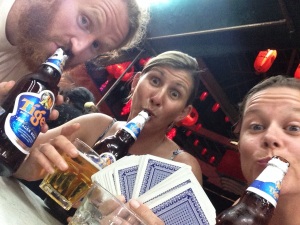
When Eleanor left for the airport at 5:30 am (either with mild hangover, or more likely probably still drunk from our final night of ‘celebrations’) Helena and I were left contemplating our options… for the first time since we began our travels, we had no set place or time to aim for anymore. It was quite a strange feeling really. It should be liberating, I suppose, but in a way it can also be quite stressful. Now, before you jump on the ‘Oh, poor you, did you have to put down your beer for a second, get up off the beach and actually plan something’ bandwagon … I’m not complaining! Honest! Merely contemplating. Helena and I lead pretty busy lives at home, and we hit the travel at the same sort of pace – or at least that’s how it felt – and now, we could meander a little bit, wander and wonder at our options, change course if we felt like it, stay longer or just move on if something caught our fancy.
And so, after some deliberation, we decided – it was time to venture into the jungle…
Borneo – just the name alone conjures up images of huge areas of dense jungle populated with various species of large primates, and insects like no other; mountains and rivers punctuating the landscape and a frame of tropical marine life completing the mental picture. Add in a couple of medium sized cities along the coastal regions and you’re pretty much there. Borneo is beautiful.
It is not, however, an unspoiled paradise – but more on that later.
Borneo is in fact the world’s third largest island (behind Greenland and Papua New Guinea; Australia doesn’t count as it’s classed as a continental land mass – apparently!) and it is shared across three countries: Malaysia, Indonesia and the self-contained sultanate of Brunei Darussalam. Our first destination was Kuching, the ‘cat’ city (although, ironically, there was a distinct lack of cats in direct contrast to pretty much everywhere else in Malaysia) in the south western Malaysian region of Sarawak. The people here are so friendly, and we were often greeted by complete strangers who simply wanted to say hello. Walking past a school in the afternoon, a young girl ran up to the gate and shouted over to us, ‘Welcome to Malaysia!’ I’m still not sure how she spotted we were foreigners so easily…
There are national parks galore in Borneo, and loads to choose from around Kuching. On arrival we had one of many planning sessions, trying to figure out what to do and where to go. We knew we wanted to get into the jungle and see the famous Orangutans and Proboscis Monkeys, but we ended up coming to the conclusion that we may as well take it just a few days at a time – we couldn’t possibly map out two weeks from this standpoint.
So, on our second day in Kuching, we jumped on a local bus and headed off to Semenggoh Nature Reserve, a sanctuary for semi-wild Orangutans. Now, I know the concept of something being ‘semi’ wild is a bit of an odd notion (surely they’re either wild or they’re not?) but Semenggoh is part of a rehabilitation programme that releases previously captive Orangutans back into the wild. They are monitored to ensure their health and safety, but not contained in any way. Their diet is supplemented with fruit during feeding times should they need it, but not all of them arrive each time. To avoid the Orangutans becoming too accustomed to people, the visiting times are strictly limited to the feeding slots: one hour in the morning and one hour in the afternoon; and it is explained to you during the briefing that there is no guarantee whatsoever that any Orangutans will actually show up. ‘Oh…’, Helena and I shared a look of mild concern.
So, off we went, led on a short walk into the jungle to the feeding platform – a large, flat wooden structure a bit like a table top that had a sizeable pile of bananas on it, and a solitary pineapple. Thick ropes lead down to the platform from high up in the surrounding trees. There were no Orangutans however. Instead, we found one of the reserve staff standing on the platform with the mound of fruit at his feet, looking optimistically up into the trees, waving a banana in his hand and calling out, ‘Haaaaooooooooooo ap!’
Not to worry, we thought, they’ll arrive soon. It was 9am and feeding time finished at 10am whether any Orangutans had shown up or not. And so we waited, anticipated, deliberated. Watched. Held our breath. Shhhhhhhhh….
Ten minutes passed. The keeper was still there, still tree-gazing, still calling although now with more desperation than optimism it seemed, ‘Haaaaooooooooooo ap? Whhhhaop? Hup?’ But nothing happened. There was no sign, no hint, no rustle of leaves, no return of the keeper’s call. Nothing.
On the viewing platform, the doubts were creeping in. People were looking around at each other, wondering if they had made a wasted trip, sitting down defeatedly. I got the occasional sideways glance from other visitors which I interpreted as, ‘Well, we may not have seen Orangutans, but we have see this other big, hairy, ginger guy.’ I’m almost certain a few of them took surreptitious pictures of me just in case.
Time ticked past; nine thirty. The keeper called to us, ‘Don’t worry, they come soon.’ Nine thirty-five; whispers on the viewing platform, ‘I’m not so sure… What a waste of time… Just our luck…’ Even Helena and I, as positive as we try to be about all of our experiences, were beginning to wonder…
Then, in the distance, high high up in the canopy ahead of us, we hear movement. The viewing platform is suddenly electric with silent anticipation. The keeper deserts the feeding platform, and we wait. You can hear them coming through the trees long before you actually see them, and although we’d heard the sound ahead, the first to arrive was actually an adolescent male coming from over our right shoulder.
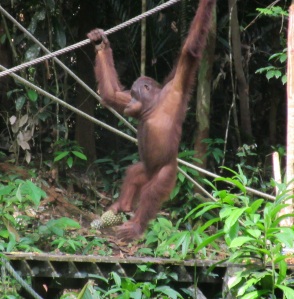
He walked through the canopy, moving with ease using his hands, and hand-like feet, until he reached one of the ropes, whereupon he paused. Seemingly contemplating for a moment, he was still, hanging from the rope by both feet and one hand. Slowly, he slid his left foot to meet his right, and then did an amazing move – a series of upside down cartwheels down the rope all the way to the feeding platform. The agility and strength of the Orangutans is seriously impressive. Once there, he didn’t hang around for long however as the first Orangutan we had heard was now also very close. Shoving four or five bananas in his mouth, grabbing another handful and picking the pineapple up with his foot, he quickly retreated half way back up the rope. There, he ate happily, and observed the other Orangutans as they too collected food.
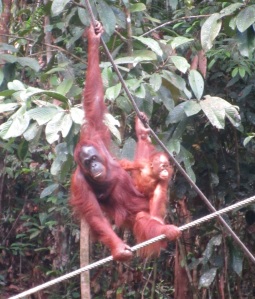
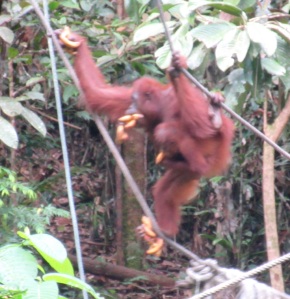
In addition to the adolescent male, there were two mother and baby pairs who also came to feed – since Orangutans were first introduced to Semenggoh, numerous babies have been born naturally in the reserve. And so, the wait was worth it! We were treated to a view of five Orangutan, close up. Incredible creatures – and a great advert for gingers the world over I might add!
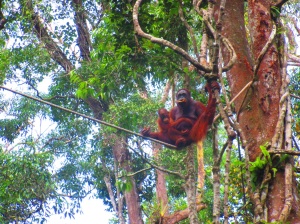
On our second day, we decided to go trekking in the jungle and so headed off to Kubah National Park where numerous trails awaited us. Helena was also keen to go to Kubah as it has the Matang Wildlife Centre attached to it. Matang is the pre-Semenggoh centre, where animals who require close support and/or treatment are rehabilitated with the eventual aim of release. Some reviews online are a little critical of Matang as the varied animals are kept in zoo-like cages or enclosures, but we felt that the centre was clearly doing a particular job and providing care for animals who would otherwise have been in a worse captive state, or indeed, dead.

We had an excellent day, spending six hours on the jungle trails, getting pretty hot and sweaty, but ending it all with a refreshing waterfall shower.
So what next?
Well, a short flight to Kota Kinabalu landed us in Sabah, the north-western region of Malaysian Borneo (we’d decided that the four border crossings involved in travelling overland through Brunei simply weren’t worth the hassle or the passport page space). A message from Caroline Hedges had tipped us off about jungle experiences on the Kinabatangan River, and so, after a little investigation, we booked onto a package that looked good at the Kinabatangan Jungle Camp.
KJC turned out to be a lot quieter than we had anticipated – no bad thing – and we were two of only four guests when we arrived, the other two being Richard and Jo, a retired couple from Essex. They were into their birdwatching and had come to Borneo for four weeks armed with binoculars and a book of Borneo’s native bird species to see what they could find. Although we went on different river cruises to them, we had a lovely time sharing our experiences and sights each day over the excellent dinner. Richard and Jo proved inspirational really – both had been teachers, both are now retired, but they still travel the world in search of new experiences. Through chatting with them we learned a huge amount about ‘birding’, but the most astonishing thing really was that they seemed to have visited almost every part of the globe in their time, and yet they were still hungry for more.
And so onto the river we went … just before dusk and just after dawn were the prime times for animal watching. On our first cruise, five minutes in, our guide Shah pointed out boat at the bank, saying, ‘I see Orangutan.’ How he spotted them, I have no idea, but he was right. There, in the trees, feeding on the figs, were a small number of wild Orangutans, including a mother and baby. They were different from the ones in Semenggoh in that their hair was a much darker reddy brown colour, but their agility, strength and magnificence were the same. They lingered in the trees as we watched on silently, enjoying their true wild nature, before they moved slowly off deeper into the forest.
Leaving the Orangutans, the cruise continued. The small wooden boat skimmed along the chocolate brown river water with ease as we gazed left and right, subconsciously searching for the jungle’s treasures. And we didn’t have to wait for long, quickly spotting a family of long-tailed macaques playing and preening on the riverbank. ‘They call them the ‘crab eating monkey,’ said Shah. ‘They fish for crab by dangling their tails in the water until a crab grabs it. Then they pull them out and eat them.’ Clever monkeys!!

We were also treated to views of snakes, silver leaf monkeys, crocodiles, many many egrets, stork billed kingfishers, rhinoceros hornbills and Borneo’s other famous jungle primate – the Proboscis Monkeys.
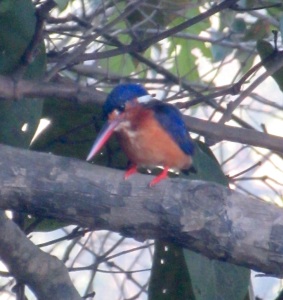
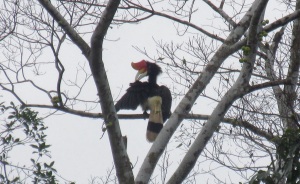
It was at the end of our first cruise that Shah said, ‘Ok, now we’ll go and see the proboscis monkeys.’ We wondered how they could be so sure where they were. Despite the obvious answer: experience, it turns out that the proboscis love a good sunset. And that’s where we found them, sat high up in the trees, watching the sun paint the sky orange. Well, who can blame them! The distinctive male Proboscis is a spectacular sight as he sits, brazenly in the top of tree, proudly showing off his bulbous nose, large belly and, with legs spread as wide apart as possible, his bright red, er, well … penis.
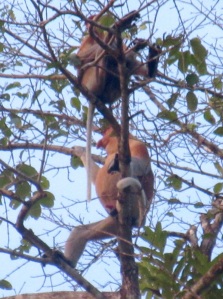
Shah explained that there are three groups within the Proboscis pack: the family group – where males and females look after their young; the harem group – where one dominant male rules supreme and has numerous females in attendance; and the bachelor group – the ‘boys club’ – where the remaining adolescent males stalk the harem, waiting for the dominant male to select a partner and graduate to the family group, at which point the boys can fight it out to take his spot.
Back at the camp, the wildlife was never far away, with regular visits from macaques, squirrels, bearded wild boar, a storm stork, the ever-prowling monitor lizards, and ‘Tom’ the civet cat! Add to that a myriad of insects and you get the picture. There were even Pygmy elephant footprints near by. So the Kinabatangan River trip proved to be an excellent few days – thanks for the tip Caroline!

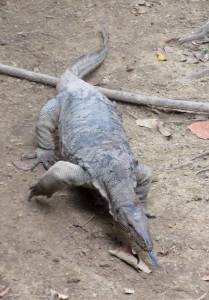
There is one more thing I must write here however. One of the reasons that the Kinabatangan River is such a prime place to spot wildlife, is that much of the rest of the natural habitat for these creatures no longer exists. Much of the primary and secondary jungle in Sabah has been felled and is presently being used to produce palm oil. It is quite staggering really – and anyone who has taken the bus from Kota Kinabalu to Sandakan will back me up – that the view from the road is one of palm trees as far as the eye can see. Acres and acres and acres of palm oil plantations dominate the landscape, and the monotony of the sight is pretty depressing, a far cry from the mental image of Borneo at the start of this blog. And so the animals have had to retreat to the river, where pockets of primary jungle still exist in which they can survive. Good for us, terrible for them.
But what is the story here? Is it a simple case of scandalous ecological disaster? Of governments having no concern for the life of the planet as a whole? Of farmers not caring? Well, I fear the complexities of the situation are far too detailed for this blog, but we did have an interesting conversation, along with Richard and Jo, with Robert – the main guide at KJC. Robert explained a little of the history of the situation:
‘I know what you think,’ he says. ‘You come here and all you see is palm oil, palm oil, palm oil and you condemn it outright because you want to see the jungle. But fifty years ago, the Malaysians had no resources, nothing. What did they have? The jungle. So they cut down trees for logging, and they make a life out of cutting down the jungle. But as time goes on, you have to go deeper and deeper into the jungle to get trees, and the timber doesn’t have as much value anymore, so what do you do? Now, you still have nothing, except land for farming – so the Malaysian government decided they would give away huge portions of land to grow crops. But they had no idea what to plant! Coffee sounded like a good idea, as did cocoa, but when the monsoon came, it killed the plants. In the end, people tried palm, and it worked. And so they planted more and more palm trees, and produced ever more quantities of palm oil. Most of it is being shipped to China, or the U.S.A. So we have an industry that supports the people, the families and the economy. We can finally build schools, roads and hospitals. Now, what do the West do? They criticise it, they ban it, they lobby against it because they say, ‘Palm oil destroys the rainforests.’ But the rainforest was already gone,’ he cries emphatically, ‘years before they planted the first palm tree. So why do they do it? Economics? Maybe. Politics? Probably. Out of concern for the environment? Of course not! It’s all very well for the West to sit there and say, ‘You shouldn’t plant palm, you’re destroying the planet,’ but what help do they give us instead? Nothing.’
He was speaking very passionately, as a man who cares deeply about the life of the jungle and all of its inhabitants, and yet also as someone who has seen the story play out first-hand over decades. I can’t vouch for the accuracy of the information, but it certainly was an interesting conversation and raised huge questions about our environmental responsibility. With the UK General Election having just taken place, where the swing of votes was seemingly driven by a set of highly insular issues, you do wonder at your place, our place, in the global community. It’s all very well making sweeping judgements about the way developing countries use the resources available to them; it’s all very well judging and criticising as farmers living in wooden shacks cut down another acre of rainforest so they can plant a crop to support their family; but what do we do? Look on aghast, and cry out ‘How could they?’ What is our standpoint? As talk of closing borders, getting out of Europe, boosting our economy, closing our eyes, looking after ourselves and nobody else seems to reverberate around the chambers of power, you really do begin to wonder at the state of the nation, and of the world. I’m not saying I have the answers, and I know the situations are incomprehensibly complex … and yet it seems so simple at times. No matter how many long haul plane rides and overnight train journeys we take, how many border crossings or visa checks we pass, we still end up on the same earth, under the same sky, breathing the same air.
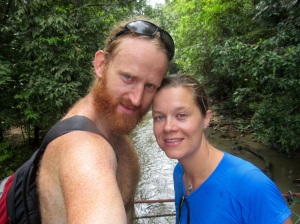

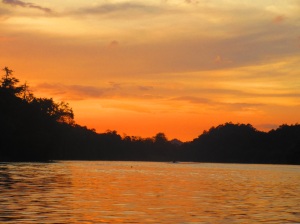

Great blog guys! Very amusing and informative.
Bit random, but following on from your comment, I saw an Orangutan with alopecia once. He looked like Vin Diesel on steroids. They all look like that of course, but you cant see it and they just appear far more cuddly with all that hair.
Keep up the good work, (I hear there’s an opening at “The Times” for a travel writer).
LikeLiked by 1 person
Cheers ABH – I did feel a certain ginger affinity with the men of the trees it has to be said! And quite enjoying the writing, but then there is so much material…!!
LikeLike
Really enjoying reading these blogs. Thanks for taking the time to write them. Miss you, but loving hearing about your adventures. Lots of love to you both. Xx
LikeLiked by 1 person
Thanks Joan! The writing can take a bit of time, it has to be said, but I (we) really enjoy it to be honest. A bit of a chance to share what we’re up to but also reflect on the experience too. Only problem now is that they’re getting a bit long………! Xx
LikeLike